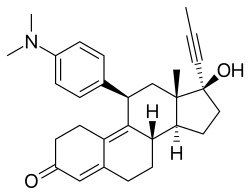Antiprogestogen
Antiprogestogens, or antiprogestins, also known as progesterone antagonists or progesterone blockers, are a class of drugs which prevent progestogens like progesterone from mediating their biological effects in the body. They act by blocking the progesterone receptor (PR) and/or inhibiting or suppressing progestogen production. Antiprogestogens are one of three types of sex hormone antagonists, the others being antiestrogens and antiandrogens.[1]
| Antiprogestogen | |
|---|---|
| Drug class | |
 Mifepristone, an antiprogestogen that is used to induce medical abortions. | |
| Class identifiers | |
| Synonyms | Antiprogestins; Progesterone antagonists; Progesterone blockers |
| Use | Medical abortion, emergency contraception, uterine fibroids |
| ATC code | G03XB |
| Biological target | Progesterone receptor |
| Chemical class | Steroidal |
| In Wikidata | |
Antiprogestogens are used as abortifacients and emergency contraceptives and in the treatment of uterine fibroids. They are also being studied in the treatment of breast cancer. Examples of antiprogestogens include the progesterone receptor weak partial agonist mifepristone, the selective progesterone receptor modulator (SPRM) ulipristal acetate, and the silent antagonist aglepristone.[2][3] For medical abortion, mifepristone is combined with a prostaglandin (e.g., gemeprost).
Several hundred antiprogestogens have been developed, but only three, mifepristone, lilopristone, and onapristone, have been given to humans, and of these, only mifepristone has been approved and introduced for clinical use.[4]
References
- Judi Lindsley Nath (2006). Using Medical Terminology: A Practical Approach. Lippincott Williams & Wilkins. pp. 977–. ISBN 978-0-7817-4868-1.
- Spitz, IM. (Oct 2006). "Progesterone receptor antagonists". Curr Opin Investig Drugs. 7 (10): 882–90. PMID 17086932.
- Tang, OS.; Ho, PC. (Dec 2006). "Clinical applications of mifepristone". Gynecol Endocrinol. 22 (12): 655–9. doi:10.1080/09513590601005946. PMID 17162706.
- Thomas H. Bourne; George Condous (17 October 2006). Handbook of Early Pregnancy Care. CRC Press. pp. 41–. ISBN 978-0-203-01621-3.
External links

- Antiprogestin entry in the public domain NCI Dictionary of Cancer Terms
![]()